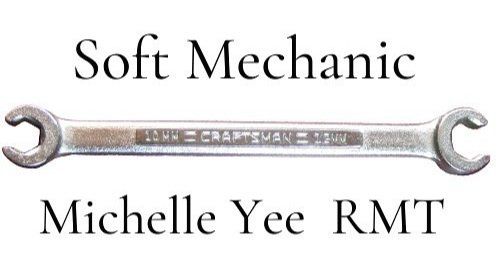Treatments
From gentle relaxation to deep tissue treatments, Registered Massage Therapy can provide the tune-up your body needs. While all registered massage therapists (RMTs or MTs) in Ontario follow the same rigorous training and are regulated health professioinals, our individual approaches can vary.
Here’s what to expect of Soft Mechanic
The treatment room is a light-filled, restful and minimalist loft space with warm wood floors, and thriving plant life. It also smells really good. My studio mate, Florence Bowen of Dear Osteopathy, has created a lovely and professional environment to receive care and rest. I’m excited to practice in such a plum space and hope you enjoy it as much as I do.
I care about details.
There’s a soft heating pad on the table if you like to feel cozy. I use bolsters and other soft props to make your body most comfortable (a little cushioning under the shoulders can mean a world of difference if you feel like you are constantly hunching forward, or your chest feels squished when lying on your stomach). I love music – all kinds of music. I’m always making new playlists and I invite clients to share their own Spotify picks with me in advance, whatever gets you to that place.
You’re not just a sore back or neck to me.
Expect our initial intake to be about 10-15 minutes. You’re not just a sore back or neck to me – you’re a whole, and it’s helpful to talk about your needs in full so that I can tailor your treatment. I always want my clients to feel like they have lots of choices, are safe and completely comfortable. I want you to leave feeling great and that you got exactly the experience you were looking for (or better!).
How you can have your best ever massage
When you’re receiving a massage with any practitioner, there are things you can do yourself and things you can ask for that can turn an ordinary experience into just-right-for-you.
Give yourself permission to rest
Once on the table, don’t feel any pressure to chit-chat – just enjoy the calm and quiet
Pay attention to your breathing. Let it slow. Use this to quiet your mind so you can really be present for your massage
Wear whatever undergarments make you feel most comfortable or go nude, as you prefer. Your waist and chest are covered at all times and only the specific body part that we are treating will ever be undraped at one time. Your comfort is most important
Ask for the pressure you like – gentle or firm, lighter or deeper – at any point during the treatment
Ask for no music, different music or bring your own music
If possible, silence your phone or leave it outside the treatment room. You’ll enjoy your massage more without listening to text notifications.
Tell the therapist if you’re uncomfortable on the table – we can work magic with soft towels or bolsters. We can treat you lying in a different position or even seated
Don’t worry if you fall asleep (or snore) – that’s a compliment of the highest order
Massage Techniques + Modalities
Swedish Massage
Swedish Massage is the type of body work most people are familiar with and is often covered by extended health care plans. All registered massage therapists in Ontario are trained in Swedish massage and have undergone extensive examination to become regulated health professionals. This type of massage is not only effective for stress management but also many types of musculo-skeletal conditions such as:
low back pain
muscle strain and spasm
ligament sprain
headaches
neck and shoulder tension
tendinitis
nerve compression syndromes
Myofascial Release
Myofascial Release can be used during a Swedish massage to encourage healing of certain conditions and injuries. It’s a “dry massage”, which means I don’t use oils or lotions so that I can sensitively feel the condition of your fascia. By applying appropriate, firm but gentle pressure, we can loosen the “covering” over your muscles, which can make your whole body feel less restricted and more naturally in balance. It can be especially useful for mobilizing scar tissue post-surgery. If I think Myofascial Release would make sense for you, I’ll recommend it.
Trigger Point Therapy
Trigger Point Therapy treats taut, hyper-irritable bands in a muscle that often accompany musculo-skeletal injury, and create very specific referral pain patterns. If you have tension headaches, for instance, trigger point therapy might be a useful technique to incorporate into your massage treatment. I will apply consistent, firm pressure to specific areas until they release. It can be a little uncomfortable at the time but the durations are short and the positive effects can be dramatic.
Some of the conditions that trigger points can mimic are:
headaches
sciatica
carpal tunnel syndrome
jaw and tooth pain with no evidence of cavity or decay
